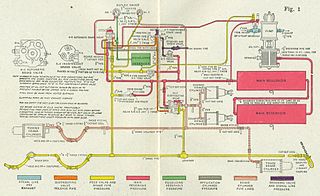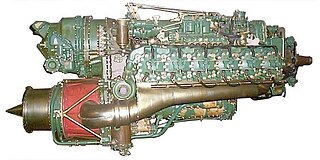Related Research Articles

In an internal combustion engine, a turbocharger is a forced induction device that is powered by the flow of exhaust gases. It uses this energy to compress the intake air, forcing more air into the engine in order to produce more power for a given displacement.

In engineering, the Miller cycle is a thermodynamic cycle used in a type of internal combustion engine. The Miller cycle was patented by Ralph Miller, an American engineer, U.S. patent 2,817,322 dated Dec 24, 1957. The engine may be two- or four-stroke and may be run on diesel fuel, gases, or dual fuel. It uses a supercharger or a turbocharger to offset the performance loss of the Atkinson cycle.

A pulsejet engine is a type of jet engine in which combustion occurs in pulses. A pulsejet engine can be made with few or no moving parts, and is capable of running statically. The best known example is the Argus As 109-014 used to propel Nazi Germany's V-1 flying bomb.

A two-strokeengine is a type of internal combustion engine that completes a power cycle with two strokes of the piston in one revolution of the crankshaft. A four-stroke engine requires four strokes of the piston to complete a power cycle in two crankshaft revolutions. In a two-stroke engine, the end of the combustion stroke and the beginning of the compression stroke happen simultaneously, with the intake and exhaust functions occurring at the same time.

A turbofan or fanjet is a type of airbreathing jet engine that is widely used in aircraft propulsion. The word "turbofan" is a combination of the preceding generation engine technology of the turbojet, and a reference to the additional fan stage added. It consists of a gas turbine engine which achieves mechanical energy from combustion, and a ducted fan that uses the mechanical energy from the gas turbine to force air rearwards. Thus, whereas all the air taken in by a turbojet passes through the combustion chamber and turbines, in a turbofan some of that air bypasses these components. A turbofan thus can be thought of as a turbojet being used to drive a ducted fan, with both of these contributing to the thrust.

A railway air brake is a railway brake power braking system with compressed air as the operating medium. Modern trains rely upon a fail-safe air brake system that is based upon a design patented by George Westinghouse on April 13, 1869. The Westinghouse Air Brake Company was subsequently organized to manufacture and sell Westinghouse's invention. In various forms, it has been nearly universally adopted.

A blowoff valve is a pressure release system present in most petrol turbocharged engines. Blowoff valves are used to reduce pressure in the intake system as the throttle is closed, thus preventing compressor surge.

In automotive engineering, an exhaust manifold collects the exhaust gases from multiple cylinders into one pipe. The word manifold comes from the Old English word manigfeald and refers to the folding together of multiple inputs and outputs.

Automatic Performance Control (APC) was the first engine knock and boost control system. The APC was invented by Per Gillbrand at the Swedish car maker SAAB. U.S. patent 4,372,119
A wastegate is a valve that controls the flow of exhaust gases to the turbine wheel in a turbocharged engine system.

An exhaust system is used to guide reaction exhaust gases away from a controlled combustion inside an engine or stove. The entire system conveys burnt gases from the engine and includes one or more exhaust pipes. Depending on the overall system design, the exhaust gas may flow through one or more of:

The OM617 engine family is a straight-5 diesel automobile engine from Mercedes-Benz used in the 1970s and 1980s. It is a direct development from the straight-4 OM616. It was sold in vehicles from 1974 to 1991. The OM617 is considered to be one of the most reliable engines ever produced with engines often reaching over 1,000,000 km (620,000 mi) without being rebuilt and is one of the key reasons for Mercedes' popularity in North America in the 1980s, as it was powerful and reliable compared to other automotive diesels of the time. It is also a very popular choice for the use of alternative fuels, mainly straight or waste vegetable oil and biodiesel, although the use of these fuels may cause engine damage over time if not processed properly before use.
The anti-lag system (ALS) is a method of reducing turbo lag or effective compression used on turbocharged engines to minimize turbo lag on racing or performance cars. It works by delaying the ignition timing and adding extra fuel to balance an inherent loss in combustion efficiency with increased pressure at the charging side of the turbo. This is achieved as an excess amount of fuel/air mixture escapes through the exhaust valves and combusts in the hot exhaust manifold spooling the turbocharger creating higher usable pressure.

Variable-geometry turbochargers (VGTs), occasionally known as variable-nozzle turbochargers (VNTs), are a type of turbochargers, usually designed to allow the effective aspect ratio of the turbocharger to be altered as conditions change. This is done with the use of adjustable vanes located inside the turbine housing between the inlet and turbine, these vanes affect flow of gases towards the turbine. The benefit of the VGT is that the optimum aspect ratio at low engine speeds is very different from that at high engine speeds.

A crankcase ventilation system (CVS) removes unwanted gases from the crankcase of an internal combustion engine. The system usually consists of a tube, a one-way valve and a vacuum source.
A jet engine performs by converting fuel into thrust. How well it performs is an indication of what proportion of its fuel goes to waste. It transfers heat from burning fuel to air passing through the engine. In doing so it produces thrust work when propelling a vehicle but a lot of the fuel is wasted and only appears as heat. Propulsion engineers aim to minimize the degradation of fuel energy into unusable thermal energy. Increased emphasis on performance improvements for commercial airliners came in the 1970s from the rising cost of fuel.
In turbocharged internal combustion engines, a boost controller is a device sometimes used to increase the boost pressure produced by the turbocharger. It achieves this by reducing the boost pressure seen by the wastegate.
The N series is Honda's first automotive diesel engine, an inline-four for medium-sized vehicles. It uses common rail direct injection, which Honda brands as i-CTDi. The most notable feature is the aluminium block, which uses proprietary technology in the manufacturing process to provide light weight and high rigidity. Roller chains drive two overhead camshafts. A variable-geometry turbocharger and intercooler are used.

A turbo-compound engine is a reciprocating engine that employs a turbine to recover energy from the exhaust gases. Instead of using that energy to drive a turbocharger as found in many high-power aircraft engines, the energy is instead sent to the output shaft to increase the total power delivered by the engine. The turbine is usually mechanically connected to the crankshaft, as on the Wright R-3350 Duplex-Cyclone, but electric and hydraulic power recovery systems have been investigated as well.

An internal combustion engine is a heat engine in which the combustion of a fuel occurs with an oxidizer in a combustion chamber that is an integral part of the working fluid flow circuit. In an internal combustion engine, the expansion of the high-temperature and high-pressure gases produced by combustion applies direct force to some component of the engine. The force is typically applied to pistons, turbine blades, a rotor, or a nozzle. This force moves the component over a distance, transforming chemical energy into kinetic energy which is used to propel, move or power whatever the engine is attached to.
References
- ↑ "External Wastegate Piping". www.sincocustoms.com. Retrieved 16 May 2024.
- ↑ "The Ultimate Guide to External Wastegates". www.turbosmart.com. 18 October 2022. Retrieved 16 May 2024.
- ↑ WJ, Chai (15 July 2021). "Screamer Pipe Explained: Horsepower, Sound & Is It Legal". Car Performance Boss. Retrieved 16 May 2024.
- ↑ "Blow off valves, dump valves and screamer pipes". www.torquecars.com. Retrieved 16 May 2024.